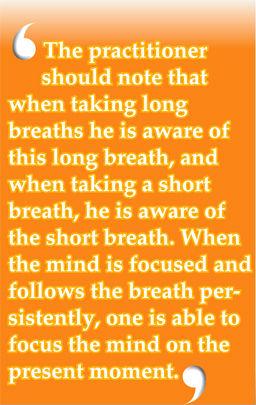|
Lesson for mindfulness – part 5:
Cultivation of
deep cognition of feelings
 Battaramulla Battaramulla
Siri Sudassanarama
sadaham senasuna
Ven. Dr. Mirisse Dhammika thero
This breathing Bhavana procedure can become part of daily life, but this does
not mean that we can focus on the breath all the time. The training program of
breathing Bhavana is for a set time each day. However, the student may
eventually be able to practice mindfulness of the breath from time to time
throughout the day,
 especially at those times when feeling restless. Here, it should also be noted
that Anapanasati is not a breathing exercise. It is instead the practice of
mindfulness using the breath as a focusing tool. There is no attempt to control
the breathing in any particular way. We let the mind be aware of the breath, and
observe the motion of the air while we concentrate on our breathing – in and
out. When we breathe, we sometimes take long breaths, sometimes short. Instead
the breaths should be normal, natural and calm. The practitioner should note
that when taking long breaths he is aware of this long breath, and when taking a
short breath, he is aware of the short breath. When the mind is focused and
follows the breath persistently, one is able to focus the mind on the present
moment. The practitioner can recognize the warm feelings that arise at the
nostrils or any other part of the body from the heat generated by the breathing
process. Nevertheless, the mind does not stay all the time with the feelings of
the breath. especially at those times when feeling restless. Here, it should also be noted
that Anapanasati is not a breathing exercise. It is instead the practice of
mindfulness using the breath as a focusing tool. There is no attempt to control
the breathing in any particular way. We let the mind be aware of the breath, and
observe the motion of the air while we concentrate on our breathing – in and
out. When we breathe, we sometimes take long breaths, sometimes short. Instead
the breaths should be normal, natural and calm. The practitioner should note
that when taking long breaths he is aware of this long breath, and when taking a
short breath, he is aware of the short breath. When the mind is focused and
follows the breath persistently, one is able to focus the mind on the present
moment. The practitioner can recognize the warm feelings that arise at the
nostrils or any other part of the body from the heat generated by the breathing
process. Nevertheless, the mind does not stay all the time with the feelings of
the breath.
 The mind generates images, memories, emotions and fantasies. The
mind also comes into contact with external factors such as sounds, smells, heat
or cold. When these distractions occur, the practitioner should pay attention to
the state of mind created when consciousness comes into contact with these
internal and external stimuli. In a little while, as these distractions fade
away, the practitioner should allow his mind to return to the breath, and every
time the mind returns to the breath, the practitioner can cultivate a deep
cognition of feelings and thoughts: thoughts and feelings rise and fade away one
after another. The mind generates images, memories, emotions and fantasies. The
mind also comes into contact with external factors such as sounds, smells, heat
or cold. When these distractions occur, the practitioner should pay attention to
the state of mind created when consciousness comes into contact with these
internal and external stimuli. In a little while, as these distractions fade
away, the practitioner should allow his mind to return to the breath, and every
time the mind returns to the breath, the practitioner can cultivate a deep
cognition of feelings and thoughts: thoughts and feelings rise and fade away one
after another.
Thus the practitioner realizes the impermanent nature of all
mental objects (Gunaratana). Gradually, as the practitioner becomes used to the
perception of impermanence , she has less selfish-attachment to both positive
and negative emotions. She is able to let go of disturbing emotions and
thoughts. When we train our minds by concentrating on breathing and as we become
familiar with this practice, we can begin to use it in our daily activities
without any conscious effort. In other words, we can use the mindfulness that we
cultivate by concentrating on the breath, to focus on listening, writing,
talking, cleaning, cooking and even driving.
Especially for students, when they struggle with their concentration, they can
bring mindfulness practice on the breath to daily studies. For instance, when
they read a book they should keep total awareness on the words.
They have to take time and concentrate on their breath until they feel calmness,
mentally and physically. This peace of mind helps them to maintain undisturbed
bare attention on their studies. I will now explore more clearly how this
mindfulness can be implemented by students to cope with negative emotions and
feelings such as anger and restlessness arising from their daily lives. |